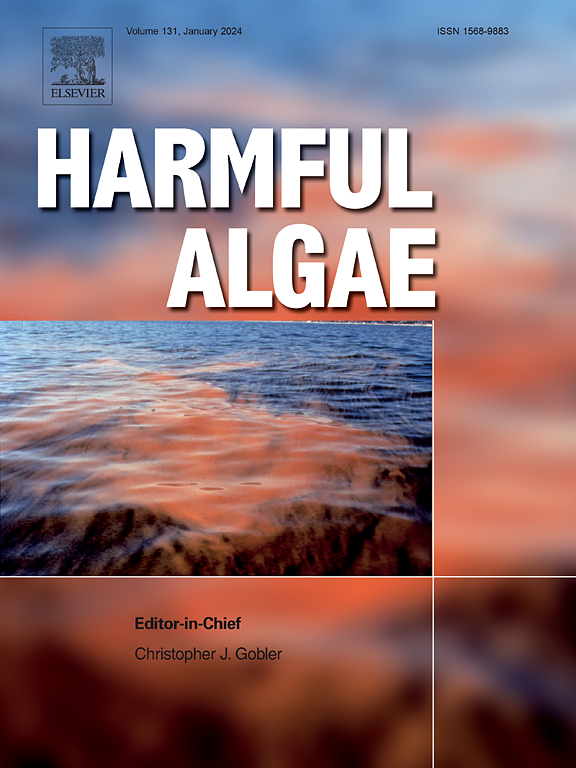Raphidiopsis raciborskii AWT205中圆筒精子素生物合成(cyr)基因簇的转录调控
IF 4.5
1区 生物学
Q1 MARINE & FRESHWATER BIOLOGY
引用次数: 0
摘要
蓝藻有害藻华(HABs),产生肝毒素圆柱精子素(CYN),是全球最常见的报道之一。虽然编码CYN生物合成的基因簇(cyr)已经测序,但CYN调控的许多方面尚未解决。本研究通过计算机分析、反转录定量PCR (RT-qPCR)和dna亲和捕获法(daca)研究蓝细菌Raphidiopsis raciborskii AWT205中cyr的转录调控。虽然硅分析确定了整个cyr簇中环境响应转录因子的结合位点,但daca捕获了AbrB(一种调节蓝藻对氮和铁可用性反应的转录因子)与cyrD启动子的结合。令人惊讶的是,起始的圆柱体精子蛋白酶合成酶CyrA也被cyrD启动子探针捕获。这是CYN(和蓝藻毒素)自动调节的第一个实验证据。我们的研究也是对cyr转录最广泛的研究,同时针对三个生长阶段的9个cyr基因。我们发现每个cyr基因的转录水平之间存在显著的异质性,并且在不同的生长阶段也存在差异。令人惊讶的是,cyrI(羟化酶)与cyrJ(硫转移酶)转录本的比例与脱氧CYN与CYN的比例成反比。综上所述,本研究结果表明,rraciborskii AWT205中cyr基因簇的转录是由多个启动子和dna结合蛋白驱动的,这些启动子和dna结合蛋白可以响应不断变化的环境条件。然而,不同CYN变体的产生并不仅仅与转录相关,还提出了其他的调控机制。本文章由计算机程序翻译,如有差异,请以英文原文为准。
Transcriptional regulation of the cylindrospermopsin biosynthesis (cyr) gene cluster in Raphidiopsis raciborskii AWT205
Cyanobacterial harmful algal blooms (HABs), producing the hepatotoxin cylindrospermopsin (CYN), are among the most frequently reported globally. Although the gene cluster encoding CYN biosynthesis (cyr) has been sequenced, many aspects of CYN regulation are unresolved. This study investigates cyr transcriptional regulation in the cyanobacterium, Raphidiopsis raciborskii AWT205, through in silico analysis, reverse transcription quantitative PCR (RT-qPCR), and DNA-affinity capture assays (DACAs). While in silico analysis identified binding sites for environmentally responsive transcription factors throughout the cyr cluster, DACAs captured the binding of AbrB (a transcription factor that regulates the cyanobacterial response to nitrogen and iron availability) to the cyrD promoter. Surprisingly, the initiating cylindrospermopsin synthetase, CyrA, was also captured by the cyrD promoter probe. This is the first experimental evidence of CYN (and cyanotoxin) autoregulation. Our study is also the most extensive investigation of cyr transcription, concurrently targeting nine cyr genes across three growth stages. We found significant heterogeneity between transcription levels of each cyr gene, which also varied across different growth stages. Surprisingly, the ratio of cyrI (hydroxylase) to cyrJ (sulfotransferase) transcripts was inversely proportional to the ratio of deoxyCYN to CYN. Taken together, the results of this study suggest that transcription of the cyr gene cluster in R. raciborskii AWT205 is driven by multiple promoters and DNA-binding proteins, that can be responsive to changing environmental conditions. However, the production of different CYN variants did not correlate to transcription alone, with additional regulatory mechanisms proposed.
求助全文
通过发布文献求助,成功后即可免费获取论文全文。
去求助
来源期刊

Harmful Algae
生物-海洋与淡水生物学
CiteScore
12.50
自引率
15.20%
发文量
122
审稿时长
7.5 months
期刊介绍:
This journal provides a forum to promote knowledge of harmful microalgae and macroalgae, including cyanobacteria, as well as monitoring, management and control of these organisms.
 求助内容:
求助内容: 应助结果提醒方式:
应助结果提醒方式:


